River Valleys
- The extended depression on the ground through which a stream flows throughout its course is called a river valley.
- At different stages of the erosional cycle, the valley acquires different profiles.
- Valleys start as small and narrow rills.
- The rills gradually develop into long and wide gullies.
- The gullies further deepen, widen, and lengthen to give rise to valleys.
- Types of river valleys
- V-Shaped Valleys
- The river is very swift as it descends the steep slope, and the predominant action of the river is vertical erosion.
- The valley developed is thus deep, narrow, and distinctly V-shaped.
- V-Shaped Valleys
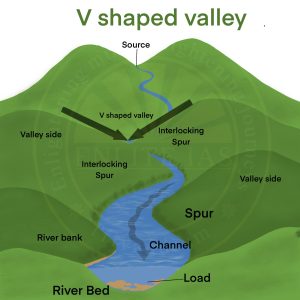
-
- Interlocking Spurs
- Interlocking spurs are projections of high land that alternate from either side of a V-shaped valley.
- Gorge
- A gorge is a deep and narrow valley with very steep to straight sides.
- A gorge is almost equal in width at its top as well as its bottom.
- Gorges are formed in hard rocks.
- For example – Indus gorge.
- Interlocking Spurs
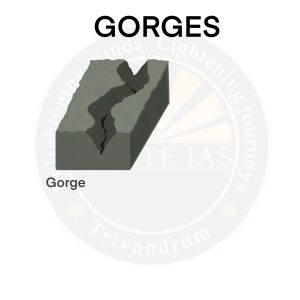
-
- Canyon
- A canyon is a variant of the gorge.
- Unlike Gorge, a canyon is wider at its top than at its bottom.
- A canyon is characterised by steep step-like side slopes.
- Canyons commonly form in horizontally bedded sedimentary rocks.
- Example – Grand Canyon carved by the Colorado River in the US.
- Canyon
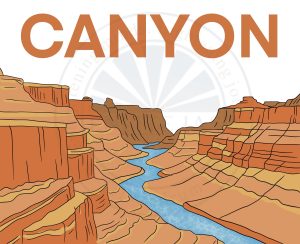
Waterfalls and Rapid
- Waterfalls
- When rivers plunge in a sudden fall of some height, they are called waterfalls.
- Their great force usually wears out a plunge pool beneath.
- Waterfalls are formed because of several factors like the relative resistance of rocks lying across the river, and the relative difference in topographic reliefs.
- For example – Angel Falls In Venezuela is the world’s highest waterfall.
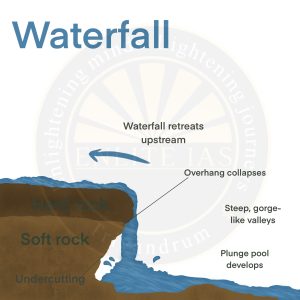
- Rapids
- A rapid is formed due to an abrupt change in the gradient of a river due to variation in the resistance of hard and soft rocks traversed by a river.
Potholes and Plunge Pools
- Potholes are more or less circular depressions formed over the rocky beds of hill streams, because of stream erosion aided by the abrasion of rock fragments.
- Once a small and shallow depression forms, pebbles and boulders get collected in those depressions and get rotated by flowing water and consequently, the depressions grow in dimensions.
- Eventually, such depressions are joined leading to the deepening of the stream valley.
- At the foot of waterfalls also, large potholes, quite deep and wide, form because of the sheer impact of water and rotation of boulders.
- These deep and large holes at the base of waterfalls are referred to as plunge pools.

Gullys and Rills
- Gully is a water-worn channel, which is particularly common in semi-arid areas.
- It is formed when water from overland flows down a slope, especially following heavy rainfall, is concentrated into rills, which merge and enlarge into a gulley.
- The ravines of Chambal Valley in Central India and the Chos of Hoshiarpur in Punjab are examples of gullies.
Incised or Entrenched Meanders
- Incised or entrenched meanders are found in hard rocks.
- They are very deep and wide and are formed in streams that flow rapidly over steep gradients. Normally, erosion is concentrated on the bottom of the stream channel.
- Entrenched meander normally occurs where there is a rapid cutting of the river bed such that the river does not erode the lateral sides.
- Meander loops are developed over original gentle surfaces in the initial stages of development of streams and the same loops get entrenched into the rocks normally due to erosion or gradual uplift of the land over which they started.
- They are widened and deepened over a long period and can be found as deep gorges and canyons in the areas where hard rocks are found.
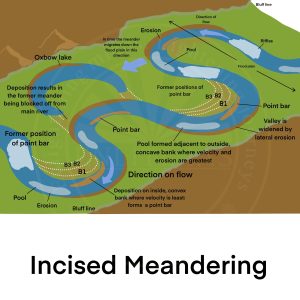
Structural Benches
- The benches formed due to differential erosion of alternate bands of hard and soft rock beds are called structural benches or terraces because of lithological control in the rate of erosion and consequent development of benches.
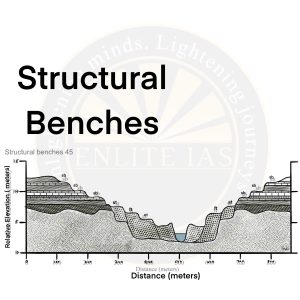
River Terraces
- The narrow flat surfaces on either side of the valley floor are called river terraces which represent the level of former valley floors and the remnants of former (older) flood plains.
- River terraces are generally formed due to the dissection of fluvial sediments of flood plains deposited along a valley floor.
- Two types are
- Paired Terraces – Paired terraces are formed due to the rapid rate of vertical erosion resulting in the occurrence of terraces on both sides of the river valley almost at the same level.
- Unpaired Terraces – Unpaired terraces are formed due to concomitant vertical erosion (valley deepening) and lateral movement of the channel.
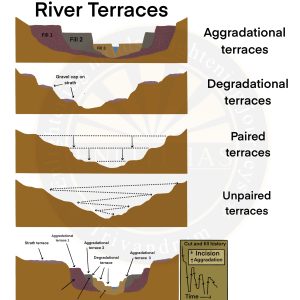
Peneplain
- A peneplain (an almost plain) is a low-relief plain which is formed as a result of stream erosion.
